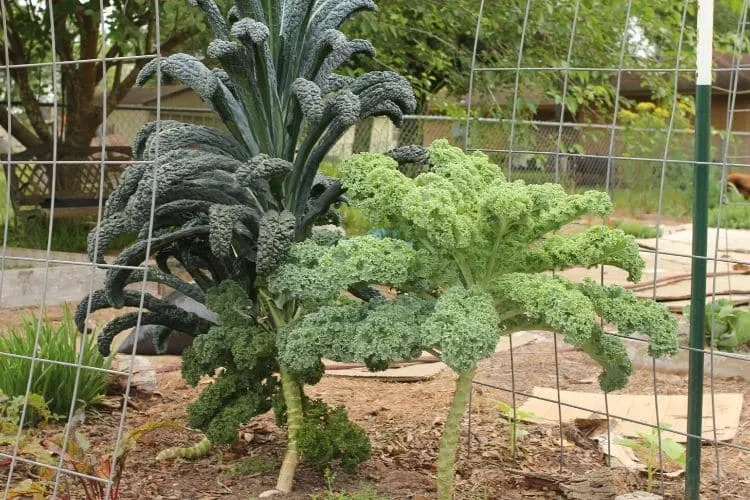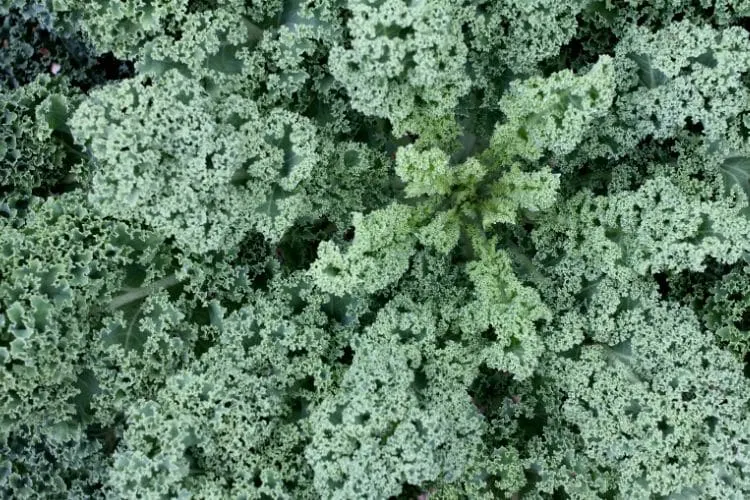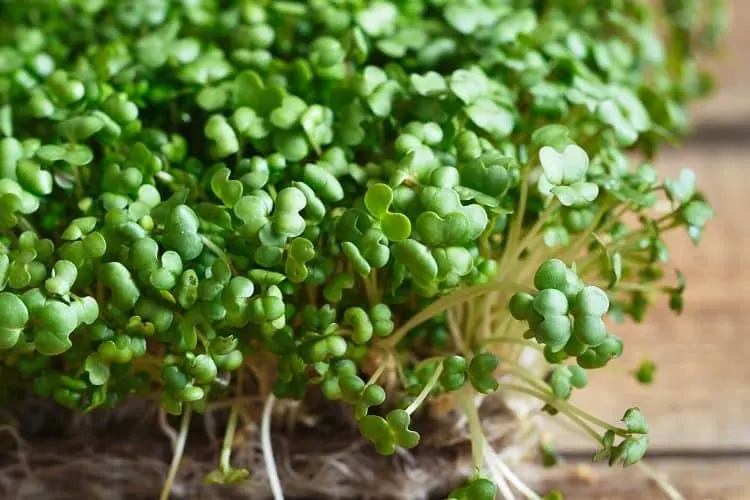Kale is one of those hardy plants that will survive both cold winters and hot summers. Growing kale is a fantastic way to fill in the harvesting gaps that can often happen when you garden year round.

Kale and other greens have gotten a bad wrap lately. I’ve read several articles by people who say that they are full of “anti-nutrients” and should be avoided.
Now, I’m not a doctor or a nutritionist, I’m just a mom. But it seems to me that that if dark, leafy greens were so bad for you than most of the cultures of the world wouldn’t be eating them every day. You know, the cultures without access to gourmet food or fast food. The cultures that grow their own food and then eat it.
In the All You Can Eat Gardening Handbook, Cam Mather states the following…
Kale is a brassica (that doesn’t start with “B” or “C”) and contains just about every vitamin known to man. It’s got phytonutrients to prevent just about every cancer out there, and studies show that when you chew cruciferous vegetables like kale it tells the liver to produce enzymes that detoxify cancer-causing chemicals, basically convincing them it’s better to just do themselves in rather than hang out in Kaletown. Kale has vitamin A and beta-carotene to help your eyes, lots of vitamin C to protect against arthritis, manganese for a healthy nervous system, calcium for healthy bones…just let me know when you want me to stop
Cam Mathers – All You Can Eat Gardening Handbook
If after doing some research you have decided that kale is not for you, then you probably shouldn’t grow kale.
But if you’re like me and think kale is great, then here’s some things you might want to know about growing Kale.

Kale Varieties to Grow
There are a few kale varieties to choose from and they’re all grown pretty much the same way. There are some differences in cold hardiness and heat tolerant but really that’s it.
All kale varieties will mature in 50-65 days but one of the great things about kale is that you can harvest the immature leaves much earlier than that. Just don’t harvest more than one-third of the leaves at a time.
Flavor and texture is a different story. Some kale varieties are more tender than others and some have a more mild flavor. I suggest trying different varieties until you find one you like. Here are some of our favorites…
Tuscan or Lacinato Kale has smooth, somewhat thin leaves. The texture and color almost look like reptile skin earning it the name Dinosaur Kale. The plant can easily grow four feet tall. We really like this variety, the leaves are more tender than the curly kale variety and our grandson will often just snap a leaf off and munch on it in the garden.
Other smooth leaf kale varieties include Black Magic, Dazzling Blue, Nero di Toscana
Vates Blue Curly Kale is what most people think of when they think of kale. It’s ruffled leaves are beautiful making it a good plant for edible landscaping. The leaves are firm and hold up even when cooked long and slow. I will say that pests tend to hide in the curly leaves more than in the flat leaves of the dinosaur kale so you’ll definitely want wash these leaves well before eating.
Other curly kale varieties include Darkibor, Dwarf Green Curled, Prism, Winterbor.
Scarlet Kale has a lovely red color and would look beautiful in an edible landscape design. These take a little longer to mature (60 days) than varieties, the longer mature time allows them to develop the deep red color and sweet, light flavor. But they are very frost tolerant so there’s no need to worry about frost. Scarlet Kale is best eaten fresh as it looses it’s texture when cooked more than other varieties do.
Other red kale varieties include Redbor and Russian Red.
There are also some broad leaf kale varieties that are often grown for salad greens such as Fizz and Bolshoi kale.
Like I said, there are a lot of kale varieties to pick from. I like to purchase seeds from MiGardener which only carries heirloom varieties and has seed packets for .99 each. If you use this link you’ll receive a 10% discount on your entire order.

Growing Kale
Kale prefers cooler weather but can tolerate temperatures well into the 90s. If you live in a warm climate like I do, plant kale in the fall and grow it over winter.
If you live where it snows, kale can be be planted as soon as the ground is workable. Kale is frost tolerant so they will survive late season frosts and is one of the earliest plants you can plant.
If you live in a cold climate you can start kale indoors 8 weeks before your average last frost date for spring planting. Then you’ll plant them when they’re 3-4″ tall even if it’s a few weeks before your average last frost date.
If you’re planting in the fall, you can start the kale indoors if you have a place set up. You’ll want to start them 6 or so weeks before your average first frost.
For us this would mean that I would be starting kale while it’s still pretty hot. Instead, I just wait until early October and sow seeds directly in the garden when we have several days of rain in the forecast. Since they will grow all winter long, I don’t feel a need to rush planting them.
Sow seeds about 1/2″ deep and about 12″ apart, kale gets really big. I like to sow several seeds in one area and then thin them for salads.
If you’re planting plant’s plant them up to the crown (where the leaves meet the roots) and 12″ apart.
Because you can harvest kale just a few leaves at a time instead of the whole plant at once, you can harvest from the same plant for months. Therefore, you don’t need to plant a lot of them to feed your family. I plant one kale plant per person in our family. If you need help deciding how much to plant for your family, I have some worksheets that can help. You can get the worksheets emailed to you by filling out the form below.

Pests and Problems with Growing Kale
Cabbage loopers and cabbage worms are probably the biggest problem with growing kale. You can spray them with Bt (Bacillus Thuringiensis) which is approved for organic use and only affects caterpillars and worms.
Snails can be a problem but we’ve never really had trouble with them. In fact, kale is one of the easiest plants for us to grow over the winter.
That being said, as the summer heat increases we do have trouble with aphids attacking our kale and Swiss chard. I’ve tried several times to grow the same kale plants that I plant in the fall through the summer to the next fall. But it never ends well.
Now I just plant new kale plants in late spring and those make it though the summer just fine.

Growing Kale in Pots
Kale grows very well in containers and really isn’t super picky about sunlight or soil. To grow kale in containers, find containers that have drain holes – you can even upcycle found items into garden pots by adding some drain holes.
The container should be filled withe general purpose potting soil. If you want to use soil from your yard, you’ll need add compost and perlite to it to make sure it’s well draining. Just know that you’ll probably have more weeds to deal with if you use soil from your yard.
Kale likes sun but if all you have is shade it will certainly tolerate it. I’ve grown kale in pots on my front porch which is mostly shade just fine.
The great thing about growing kale in containers is that you can move the containers as needed. If you think the kale needs a little sunshine, you can temporarily move it to a sunny location. If the temperatures are plummeting you can move the kale inside or into a protected area.
I’ve never grown kale indoors but if you have a sunny spot, it’s certainly worth a try.
To grow kale in containers, choose varieties that are remain compact such as Dward Blue Kale, Russian Red, and Nero di Toscana.

Growing Kale as Microgreens
Kale is fantastic when grown as microgreens. To grow kale microgreens you just need a container, a little soil, and seeds.
The container can be anything that is somewhat shallow – with or without drainage holes. I usually use items like plastic clamshell containers that salad greens come in that I’ve rescued from the recycle.
The soil needs to be loose but also be able to hold water, seed starting mix is great for growing kale microgreens.
To grow kale microgreens you need a lot of seeds. My favorite place to get them is our local feed store which sells seeds in bulk.
You can find step by step instructions for growing microgreens here. Kale isn’t the only plant good for growing as microgreens, any plant with an edible leaf is a good candidate.

Kale Companion Plants
Companion planting is really more of an art that an science, although there are some things that are widely known and practiced. If you look at 10 lists of companion plants for kale you’ll get 10 different opinions.
Some say plant kale will do just fine with potatoes and another will say not to plant it with potatoes. My best advice is to mix things up and practice crop rotation. This will build your soil and reduce pest pressure.
That being said, it’s commonly believed that some good companion plants for kale are onions, herbs such as rosemary, thyme, mint, chamomile, sage.
If you want to dig deeper into companion planting, start with this guide from West Coast Seeds.

Harvesting and Storing Kale
Harvest the outer leaves and let the plant continue to grow. They will grow quite large – two to three feet tall. The leaves will also get large which means you’ll need to harvest fewer as the plant grows. When the plant is little harvest just one or two leaves per plant until the plant gets bigger.
I normally just harvest enough kale for dinner. But if I harvest too much which is easy to do when the leaves get really large, I dehydrate them. Blanching is recommend but I don’t, I just put them in the dehydrator overnight.
The next morning I add them to a jar that I keep in my kitchen of dehydrated greens. We use these in smoothies or sprinkle in rice or on eggs.
Kale can be used anywhere that spinach can be used. The young leaves are really great in salads and the older leaves are fantastic in soups because they don’t loose their texture.

Other Frost Tolerant Plants
Kale isn’t the only frost tolerant plant, other brassicas such as cabbage, broccoli, and cauliflower are also frost tolerant. Onions, Swiss chard, and herbs such as cilantro will also survive frosts and are some of the earliest plants you can plant each spring and some of the long lasting plants each fall. Here are specifics for growing frost tolerant plants in your garden.

AJ Albera
Tuesday 15th of November 2022
I grew beautiful lacinato for the first time this year but the leaves have tiny, tiny clusters of white spots. Don’t think it’s aphids but not sure what they are. Did the soak and salt thing, didn’t work and I need a scrub brush and water to get them off. I hate to throw it all out but don’t want to serve kale with bugs! Please hey!!!
Angi Schneider
Sunday 27th of November 2022
Hmm, I have no idea other than aphids. I've found that the flat leaf kale is more resistant to pests than the curly leaf.
Jackie
Monday 17th of August 2020
Hello there thank you for this! I am so new to gardening, but want to try to grow Kale on our porch. It looks pretty and will be a great way to keep eating greens. Does Kale last forever? If I harvest leaves often and without taking too many will it keep regrowing? Thank you in advance:) Jackie
Angi Schneider
Tuesday 18th of August 2020
Kale doesn't last "forever" but it will certainly last for months on end. Just harvest the outer leaves and it will keep growing. We grow ours over winter since we live in such a hot climate. I plant it in October and can still be harvesting in June. If you're going to grow in pots, you'll want to grow a couple of them. Kale grows fast so you can always replant when it get scraggly looking. Have fun!
Tessa Zundel
Friday 18th of October 2013
We love growing kale! It continues to perform through our Utah winters, we just have to wait for it to thaw out! Those winter veggies are remarkable, biologically speaking. We shared with our FB readers at homesteadlady.com.
Lisa Lynn
Thursday 20th of June 2013
I love having kale in the garden! Yours is beautiful :) Thanks for sharing this on The HomeAcre Hop! Hope to see you again today!http://www.theselfsufficienthomeacre.com/2013/06/the-homeacre-hop-24.html
Kathy A Delightsome Life
Wednesday 19th of June 2013
I will have to wait until fall to grow Kale, but it is definitely on my list for our garden - terrific post - I'll Pin it to remember! I appreciate you sharing with Home and Garden Thursday,Kathy